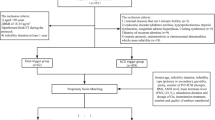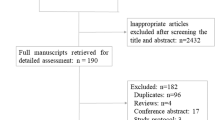Abstract
Propose
The purpose of this study was to assess whether the implementation of a "dual trigger" approach, utilizing gonadotropin-releasing hormone agonist (GnRHa) and human chorionic gonadotropin (hCG) in the GnRH antagonist protocol for in vitro fertilization (IVF), leads to improved pregnancy outcomes compared to the conventional hCG trigger alone. Previous meta-analyses have not provided sufficient evidence to support the superiority of the dual trigger over the hCG trigger in fresh or frozen embryo transfer cycles. Thus, a systematic review and meta-analysis of randomized trials were conducted to provide a comprehensive evaluation of the impact of the dual trigger on pregnancy outcomes in fresh or frozen embryo transfer cycles.
Method
A systematic review and meta-analysis of randomised controlled trials (RCTs) were conducted. We searched the Medline and Embase databases for articles up to 2023 by using search terms: “dual trigger,” “GnRHa,” “hCG,” “IVF.” Eligible RCTs comparing the dual trigger with the hCG trigger were included. The primary outcome was the live birth rate (LBR) per cycle. The secondary outcomes were the number of oocytes retrieved, number of mature oocytes retrieved, implantation rate, biochemical pregnancy rate, CPR, miscarriage rate and ovarian hyperstimulation syndrome (OHSS) rate per started cycle We compared the oocyte maturation and pregnancy outcomes in the dual trigger and hCG trigger groups. In patients undergoing fresh embryo transfer (ET) and frozen–thawed ET, we also conducted a subgroup analysis to evaluate whether dual trigger improves the clinical pregnancy rate (CPR).
Results
We included 10 randomised studies, with 825 participants in the dual trigger group and 813 in the hCG trigger group.
Compared with the hCG trigger, dual trigger was associated with a significant increase in the LBR per cycle (odds ratio (OR) = 1.61[1.16, 2.25]), number of oocytes retrieved (mean difference [MD] = 1.05 [0.43, 1.68]), number of mature oocytes retrieved (MD = 0.82 [0. 84, 1.16]), and CPR (OR = 1.48 [1.08, 2.01]). Subgroup analyses revealed that dual trigger was associated with a significantly increased CPR in patients who received fresh ET (OR = 1.68 [1.14, 2.48]). By contrast, the dual trigger was not associated with an increased CPR in the patient group with frozen–thawed ET (OR = 1.15 [0.64, 2.08]).
Conclusion
The dual trigger was associated with a significantly higher number of retrieved oocytes, number of mature oocytes, CPR, and LBR in IVF than the hCG trigger. The beneficial effect for fresh ET cycles compared with frozen–thawed ET might be associated with increased endometrial receptivity.
Relevance
After dual trigger, delaying ET due to the concern of endometrial receptivity might not be needed.








Similar content being viewed by others
Data availability
All data analyzed in this study are included in this present manuscript.
References
Griffin D, Benadiva C, Kummer N, Budinetz T, Nulsen J, Engmann L. Dual trigger of oocyte maturation with gonadotropin-releasing hormone agonist and low-dose human chorionic gonadotropin to optimize live birth rates in high responders. Fertil Steril. 2012;97(6):1316–20.
Maged AM, Ragab MA, Shohayeb A, Saber W, Ekladious S, Hussein EA, El-Mazny A, Hany A. Comparative study between single versus dual trigger for poor responders in GnRH-antagonist ICSI cycles: a randomized controlled study. Int J Gynaecol Obstet. 2021;152(3):395–400.
Zhou C, Yang X, Wang Y, Xi J, Pan H, Wang M, Zhou Y, Xiao Y. Ovulation triggering with hCG alone, GnRH agonist alone or in combination? A randomized controlled trial in advanced-age women undergoing IVF/ICSI cycles. Reproduction. 2022;37(8):1795–805.
Russell DL, Robker RL. Molecular mechanisms of ovulation: co-ordination through the cumulus complex. Hum Reprod Update. 2007;13(3):289–312.
Alyasin A, Mehdinejadiani S, Ghasemi M. GnRH agonist trigger versus hCG trigger in GnRH antagonist in IVF/ICSI cycles: a review article. Int J Reprod Biomed. 2016;14(9):557–66.
Abed WM, Selman MO. Outcome of GnRH Antagonist ICSI Cycles Triggered by GnRH Agonist Plus Recombinant hCG Versus Triggered With Recombinant hCG Alone in Fresh Autologous ICSI Cycle. Biochem Cell Arch. 2021;21(1):393–8.
Griffin D, Feinn R, Engmann L, Nulsen J, Budinetz T, Benadiva C. Dual trigger with gonadotropin-releasing hormone agonist and standard dose human chorionic gonadotropin to improve oocyte maturity rates. Fertil Steril. 2014;102(2):405–9.
Eftekhar M, Mojtahedi MF, Miraj S, Omid M. Final follicular maturation by administration of GnRH agonist plus HCG versus HCG in normal responders in ART cycles: An RCT. Int J Reprod BioMed. 2017;15(7):429–34.
Shapiro BS, Daneshmand ST, Garner FC, Aguirre M, Hudson C. Comparison of “triggers” using leuprolide acetate alone or in combination with low-dose human chorionic gonadotropin. Fertil Steril. 2011;95(8):2715–7.
Sloth A, Kjolhede M, Sarmon KG, Knudsen UB. Effect of dual trigger on reproductive outcome in low responders: a systematic PRISMA review and meta-analysis. Gynecol Endocrinol. 2022;38(3):213–21.
Gayete-Lafuente S, Moreno-Sepulveda JA, Espinos JJ, Miguel CA. Dual trigger impact on reproductive outcomes of gnrh antagonist cycles for ivf a systematic review and meta-analysis. Fertil Steril. 2021;116(3, Supplement):e242–3.
Zhang Y, Guo X, Guo L, Chang HM, Shu J, Leung PCK. Outcomes comparison of IVF/ICSI among different trigger methods for final oocyte maturation: a systematic review and meta-analysis. Faseb J. 2021;35(7):e21696.
Gonzalez VG, Triana AM, Garcia IS, Nieto SO, Urrutia MC, Garcia IC, Gastanaga-Holguera T. Dual trigger vs. Conventional trigger outcomes in In Vitro Fertilization. Systematic review and meta-analysis. JBRA Assist Reprod. 2023;27(1):112–9.
Hu KL, Wang S, Ye X, Zhang D, Hunt S. GnRH agonist and hCG (dual trigger) versus hCG trigger for follicular maturation: a systematic review and meta-analysis of randomized trials. Reprod Biol Endocrinol. 2021;19(1):78.
Ding N, Liu X, Jian Q, Liang Z, Wang F. Dual trigger of final oocyte maturation with a combination of GnRH agonist and hCG versus a hCG alone trigger in GnRH antagonist cycle for in vitro fertilization: a systematic review and meta-analysis. Eur J Obstet Gynecol Reprod Biol. 2017;218:92–8.
Zegers-Hochschild F, Adamson GD, Dyer S, Racowsky C, de Mouzon J, Sokol R, Rienzi L, Sunde A, Schmidt L, Cooke ID, Simpson JL, van der Poel S. The international glossary on infertility and fertility care, 2017. Hum Reprod. 2017;32(9):1786–801.
Schachter M, Friedler S, Ron-El R, Zimmerman AL, Strassburger D, Bern O, Raziel A. Can pregnancy rate be improved in gonadotropin-releasing hormone (GnRH) antagonist cycles by administering GnRH agonist before oocyte retrieval? A prospective, randomized study. Fertil Steril. 2008;90(4):1087–93.
Decleer W, Osmanagaoglu K, Seynhave B, Kolibianakis S, Tarlatzis B, Devroey P. Comparison of hCG triggering versus hCG in combination with a GnRH agonist: a prospective randomized controlled trial. Facts Views Vis Obgyn. 2014;6(4):203–9.
Kim CH, Ahn JW, You RM, Kim SH, Chae HD, Kang BM. Combined administration of gonadotropin-releasing hormone agonist with human chorionic gonadotropin for final oocyte maturation in GnRH antagonist cycles for in vitro fertilization. J Reprod Med. 2014;59(1–2):63–8.
Mahajan N, Sharma S, Arora PR, Gupta S, Rani K, Naidu P. Evaluation of dual trigger with gonadotropin-releasing hormone agonist and human chorionic gonadotropin in improving oocyte maturity rates: a prospective randomized study. J Hum Reprod Sci. 2016;9(2):101–6.
Alleyassin A, Ghasemi M, Aghahosseini M, Safdarian L, Sarvi F, Almasi-Hashiani A, Hosseinimousa S, Najafian A, Esmailzadeh A. Final oocyte maturation with a dual trigger compared to human chorionic gonadotropin trigger in antagonist co-treated cycles: a randomized clinical trial. Middle East Fertil Soc J. 2018;23(3):199–204.
Ali SS, Elsenosy E, Sayed GH, Farghaly TA, Youssef AA, Badran E, Abbas AM, Abdelaleem AA. Dual trigger using recombinant HCG and gonadotropin-releasing hormone agonist improve oocyte maturity and embryo grading for normal responders in GnRH antagonist cycles: randomized controlled trial. J Gynecol Obstet Hum Reprod. 2020;49(5): 101728.
Haas J, Bassil R, Samara N, Zilberberg E, Mehta C, Orvieto R, Casper RF. GnRH agonist and hCG (dual trigger) versus hCG trigger for final follicular maturation: a double-blinded, randomized controlled study. Hum Reprod. 2020;35(7):1648–54.
Haas J, Zilberberg E, Nahum R, Mor Sason A, Hourvitz A, Gat I, Orvieto R. Does double trigger (GnRH-agonist + hCG) improve outcome in poor responders undergoing IVF-ET cycle? A pilot study. Gynecol Endocrinol. 2019;35(7):628–30.
Orvieto R, Meltzer S, Rabinson J, Zohav E, Anteby EY, Nahum R. GnRH agonist versus GnRH antagonist in ovarian stimulation: the role of endometrial receptivity. Fertil Steril. 2008;90(4):1294–6.
Beckers NGM, Macklon NS, Eijkemans MJ, Ludwig M, Felberbaum RE, Diedrich K, Bustion S, Loumaye E, Fauser BCJM. Nonsupplemented Luteal Phase Characteristics after the Administration of Recombinant Human Chorionic Gonadotropin, Recombinant Luteinizing Hormone, or Gonadotropin-Releasing Hormone (GnRH) Agonist to Induce Final Oocyte Maturation in in Vitro Fertilization Patients after Ovarian Stimulation with Recombinant Follicle-Stimulating Hormone and GnRH Antagonist Cotreatment. J Clin Endocrinol Metab. 2003;88(9):4186–92.
Shapiro BS, Daneshmand ST, Garner FC, Aguirre M, Thomas S. Gonadotropin-releasing hormone agonist combined with a reduced dose of human chorionic gonadotropin for final oocyte maturation in fresh autologous cycles of in vitro fertilization. Fertil Steril. 2008;90(1):231–3.
Acknowledgements
This manuscript was edited by Wallace Academic Editing.
Funding
There was no financial or non-financial support for this study.
Author information
Authors and Affiliations
Contributions
THL and YLL designed and executed the study. LHH and YHL reviewed the literature, extracted the data and assessed the included studies' quality. LHH analyzed the data and wrote the manuscript. YYH and HJC took part in critical discussions. All authors scrutinised and revised the manuscript.
Corresponding author
Ethics declarations
Conflict of interests
The authors declare no competing interest.
Additional information
Publisher’s note
Springer Nature remains neutral with regard to jurisdictional claims in published maps and institutional affiliations.
Rights and permissions
Springer Nature or its licensor (e.g. a society or other partner) holds exclusive rights to this article under a publishing agreement with the author(s) or other rightsholder(s); author self-archiving of the accepted manuscript version of this article is solely governed by the terms of such publishing agreement and applicable law.
About this article
Cite this article
Hsia, LH., Lee, TH., Lin, YH. et al. Dual trigger improves the pregnancy rate in fresh in vitro fertilization (IVF) cycles compared with the human chorionic gonadotropin (hCG) trigger: a systematic review and meta-analysis of randomized trials. J Assist Reprod Genet 40, 2063–2077 (2023). https://doi.org/10.1007/s10815-023-02888-8
Received:
Accepted:
Published:
Issue Date:
DOI: https://doi.org/10.1007/s10815-023-02888-8




